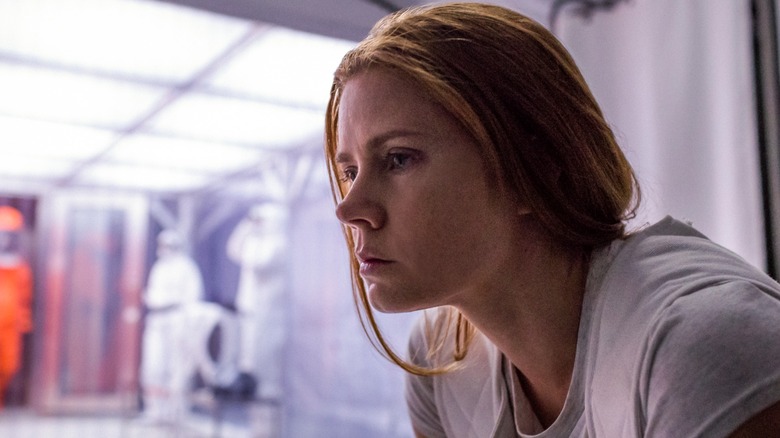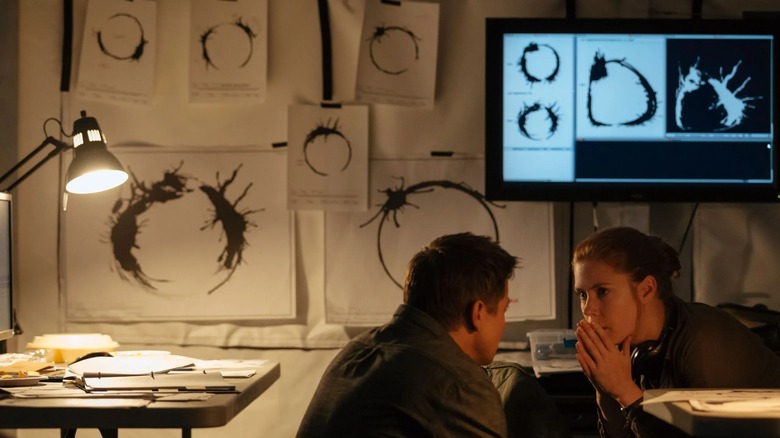The Clues You May Have Missed Leading To Arrival's Temporal Twist
This post contains spoilers for "Arrival."
The mind-boggling twist in Denis Villeneuve's "Arrival" is more than just a shift in temporal linearity. In the film's opening scenes, we learn that gifted linguist Louise Banks (Amy Adams) has lost her child, Hannah, to an unspecified illness. After Louise is brought in as a translator for the alien Heptapods — along with a team of experts, including mathematician Ian Donnelly (Jeremy Renner) — a whole new world of linguistic perception begins to unravel. Due to her empathetic attempts to communicate, Louise is gifted with the ability to experience her past, present, and future all at once, shattering the traditional human perception of sequential events. It is revealed that the scenes with Hannah take place after Louise meets the Heptapods, and her husband is none other than Ian, her research partner.
The surprising aspect of the twist is not confined to the emotional ramifications of experiencing the future, no matter how bleak or heartbreaking it might be. "Arrival" hinges on the beauty and terror of communication, its ability to change the course of the world, and how dangerous misinterpretation can be when language becomes a barrier. Every corner of the world comes up with ways to communicate with the Heptapods, but the results vary from painting a benign picture of humanity to etching an irresponsibly violent one. The Heptapods' ability to experience time without constraints evolves into a mode of communication in itself — this gift bestowed upon Louise feels transcendent, as she is treasured by a species for inventing a mode of communication that cleverly encapsulates the complexities of human experience.
Vanity Fair spoke to "Arrival" production designer Patrice Vermette and set decorator Paul Hotte in 2017, and they broke down the visual clues strewn across the film that lead up to the profound twist in question.
How time becomes a mirror in Arrival
As the different points in Louise's life blend after she experiences the temporal break, Vermette used mirrored interior settings to convey the cohesion that bleeds through her existence. Her home, where we see her spend time with Hannah, her classroom, and the spaceship where she communicates with the aliens all resemble one another, and a white wall creating a distinct open-space partition is present in all three spaces. Vermette explained this design choice in further detail:
"You can see elements of the horizontal ship chamber where Louise communicates with aliens reflected in her house and in the classroom. All three have this big white wall representation — at her house, with the big glass window overlooking the hazy lake. In her classroom, you have her whiteboard. And the chamber is divided by the big glass window ... For Louise, the idea of the chamber was pre-conveyed in her world."
Texture was also used to convey a thread of continuation, as the line-patterned walls of the spaceship can be seen in her home and her classroom, hinting at a merging of timelines and the influence that the arrival of the Heptapods had on her immediate surroundings. According to Hotte, the intent was to convey a sense of interconnectedness, along with the vast depths of wisdom that the alien race assimilated over time, proven to be too multi-layered and complicated to be transmitted via our rudimentary understanding of language alone.
Once you notice these visual clues, which follow an almost circular, ouroboros-like pattern, "Arrival" reveals itself as an even more deeply considered and profound film about the best and worst aspects of humanity in the face of the unknown.

